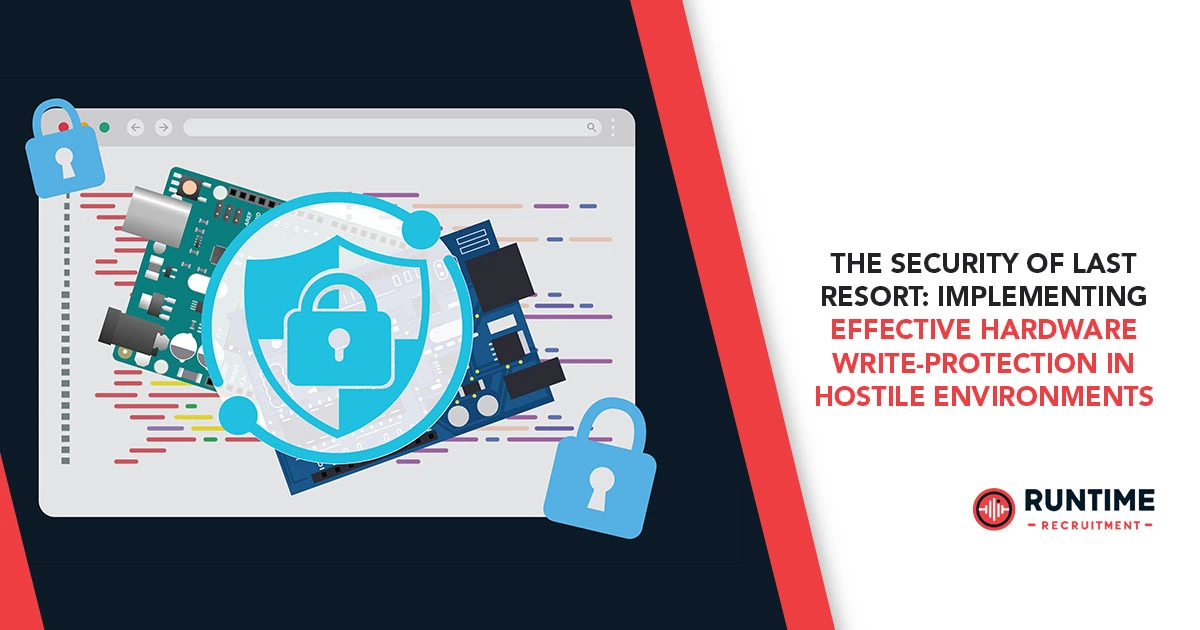In the world of embedded systems, security is a layered defense. We’ve all spent countless hours building robust software defenses: secure bootloaders, authenticated firmware updates, memory protection units (MPUs), and trusted execution environments (TEEs). We design our code to be resilient, to validate inputs, and to withstand a barrage of network-based attacks. Yet, for all this digital fortification, there’s a vulnerability that lurks just beneath the surface—a threat that software alone cannot defeat. This is the realm of physical attacks, where a determined adversary with a screwdriver and a little know-how can bypass every line of code you’ve meticulously crafted.
This isn’t an article about abstract cybersecurity threats; it’s about the tangible, physical reality of your device in a hostile environment. Think of a remote industrial sensor on a factory floor, a smart grid component in a public utility box, or a medical device left unattended in a clinic. These aren’t pristine, hermetically sealed data centers. They are vulnerable, and an attacker’s goal is often not just to steal data, but to maliciously modify the device’s behavior, permanently. To combat this, we must turn to the ultimate security measure: hardware write-protection. It’s the security of last resort, a physical lock that ensures your device’s core functionality, configuration, and identity remain immutable, even when its software defenses have been breached.
The Adversary: A Profile in Physical Attack
To understand the solution, we must first understand the threat. An adversary targeting an embedded system in a hostile environment is not your typical script kiddie. They are likely a skilled professional with specific motivations, often driven by industrial espionage, sabotage, or financial gain. Their methods are a stark departure from the network-based attacks we’re most familiar with:
- Firmware Tampering: The most common and devastating physical attack. An attacker gains physical access to the device’s non-volatile memory (e.g., flash memory, EEPROM) and uses a JTAG or SWD debugger, or even a simple off-chip programmer, to read, erase, or overwrite the device’s firmware. This can introduce a persistent backdoor, disable safety features, or completely brick the device.
- Physical Probing and Glitching: More advanced attackers may use micro-probes to directly interface with the silicon. Techniques like “power glitching” or “clock glitching” involve momentarily disrupting the power supply or clock signal to force a processor to skip an instruction, potentially bypassing a security check and allowing unauthorized access to protected memory regions.
- Side-Channel Attacks: These attacks analyze the physical effects of computation, such as power consumption, electromagnetic radiation, or timing variations, to infer cryptographic keys or other sensitive information. While not a direct write-protection bypass, this can lead to a compromise that makes write-protection irrelevant.
Software protections like secure boot and authenticated firmware updates are designed to defend against malicious software loads. However, they rely on a chain of trust that starts with the hardware. If an attacker can physically manipulate the hardware, they can potentially break that chain. This is why a physical, hardware-enforced write-protection mechanism is the final, critical line of defense. It makes the device’s core identity and operating code literally unchangeable, regardless of what software or physical manipulation is attempted.
The Last Line of Defense: Hardware Write-Protection Mechanisms
Hardware write-protection isn’t a single solution but a suite of techniques, each with its own trade-offs in cost, complexity, and security. The choice of method depends heavily on the threat model and the criticality of the device’s function.
1. On-Chip Write Protection (The Most Robust)
This is the most secure form of write protection, as it’s baked directly into the silicon. Many modern microcontrollers and SoCs (Systems on a Chip) come with dedicated fuse bits or lock bits that, once programmed, permanently disable the ability to read or write to certain memory regions.
- One-Time Programmable (OTP) Fuses: These are the gold standard. OTP fuses are memory cells that can be “blown” once to change their state permanently. An embedded engineer can use OTP fuses to lock down a bootloader, a cryptographic key, or a crucial configuration value. Once blown, there is no way to reverse the change. This is ideal for boot code that should never, ever be modified.
- Flash/EEPROM Lock Bits: Most microcontrollers with on-board flash or EEPROM memory have dedicated configuration bits that can be set to protect memory pages from being erased or written. These are often controlled by the programmer during the final manufacturing step. While highly effective, they can sometimes be vulnerable to advanced physical attacks that exploit weaknesses in the silicon, but they remain a formidable barrier for most attackers.
- JTAG/SWD Disabling: The debugging ports (Joint Test Action Group/Serial Wire Debug) are an attacker’s best friend. They offer direct, low-level access to the chip’s internal state and memory. By blowing a dedicated fuse or setting a configuration bit, these ports can be permanently disabled in the production version of a device. This is a critical step in securing any device deployed in the field, as it removes the easiest vector for physical memory dumping and manipulation.
2. External Memory Write-Protection
Not all embedded systems have their critical code and data on-chip. Many rely on external non-volatile memory, such as NOR or NAND flash, for firmware and file systems. Protecting this external memory requires different strategies.
- Dedicated Hardware Write-Protect Pins: Many memory chips, especially NOR flash, have a dedicated hardware pin (often labeled /WP or WP#) that, when held at a specific voltage (e.g., tied to GND), physically prevents the chip from being written to or erased. This is a simple, effective, and low-cost solution. The host microcontroller or a dedicated external circuit can control this pin. The key is to ensure the pin’s state is controlled in a tamper-resistant way, perhaps by a latching circuit that can’t be easily reversed.
- Firmware-Enforced Write-Protection: This is a software-based approach that complements hardware protections. The microcontroller’s firmware can be programmed to set specific registers on the external memory chip to make it read-only. While this is a common practice, it is fundamentally less secure than a hardware-enforced pin because an attacker who gains control of the host microcontroller can simply bypass these software commands. It’s a useful defense-in-depth measure, but it’s not a true “security of last resort.”
- Secure Storage Modules: For systems with highly sensitive data, a dedicated hardware security module (HSM) or a trusted platform module (TPM) can be used. These modules have their own physically protected memory and a dedicated processor. They can be programmed to store keys, certificates, and critical data in a way that is highly resistant to physical probing and tampering. They can also manage a write-protection scheme for external memory, acting as a gatekeeper that only allows writes after a robust authentication process.
Designing for Immutability: A Practical Guide for Engineers
Implementing effective hardware write-protection is a mindset shift. It’s about treating your device’s core firmware and configuration as sacred, unchangeable artifacts. This isn’t just about flipping a switch; it’s a fundamental part of the design process.
1. Stratify Your Memory: Not all data is created equal. Your design should categorize memory into different tiers of sensitivity and permanence.
- Immutable Boot Code (Tier 1): This is your secure bootloader, the root of trust. It should be stored in on-chip flash memory and protected with permanent OTP fuses or lock bits. It should never be writable after the device leaves the factory floor.
- Writable Firmware (Tier 2): The main application code and operating system. This code needs to be updatable for bug fixes and new features. It should reside in a separate memory region, protected by a secure boot process. Only the secure bootloader, after a successful cryptographic verification of the new firmware image, should be able to initiate a write/erase cycle.
- User Data & Configuration (Tier 3): This includes logs, settings, and user-specific data. This memory must be writable but should be protected with a robust access control and integrity checking mechanism.
2. The Secure Boot Chain of Trust: Hardware write-protection is the physical anchor for the secure boot process. The immutable boot code (Tier 1) contains the public key used to verify the digital signature of the writable firmware (Tier 2). If the boot code is write-protected, an attacker cannot replace the public key with their own, ensuring that only officially signed firmware can ever be loaded.
3. Anti-Tamper Measures: Hardware write-protection doesn’t exist in a vacuum. It must be paired with other physical security measures.
- Tamper-Evident Seals: Simple, low-cost stickers or seals that break upon attempted entry. These provide a clear visual indication of tampering.
- Encapsulation and Potting: For highly sensitive devices, the entire circuit board can be encased in an opaque epoxy or potting compound. This makes physical access and probing incredibly difficult, often destroying the board in the process of attempted removal.
- Enclosure Design: Design the device casing with screws that are difficult to remove or use specialized fasteners. Avoid easily accessible ports and test points on the final production board.
4. The Cost-Benefit Analysis: Not every device needs to be a hardened vault. A consumer toy might require a simple write-protect pin, while a defense-critical drone requires a multi-layered system of OTP fuses, potting, and a secure boot process. The key is to conduct a thorough threat assessment and design a security architecture that is commensurate with the value of the asset and the motivations of the likely adversary.
Conclusion: A Foundation of Trust
In the volatile landscape of embedded systems, a robust hardware-enforced write-protection strategy is no longer optional—it’s foundational. It is the architectural anchor that provides a root of trust for all subsequent software security layers. By embracing this “security of last resort,” embedded engineers can create devices that are not only resilient to network attacks but are also physically impervious to tampering. This ensures the integrity and reliability of our systems, even when deployed in the most hostile and exposed environments.
This isn’t just about protecting code; it’s about protecting function, safety, and reputation. It’s about knowing that no matter what an attacker does to your device, its core identity and intended purpose will remain forever unchanged.
Got a handle on hardware security, but need the right team to build it? Connect with RunTime Recruitment. We place top-tier embedded engineers who live and breathe security. Find your next role or your next hire.









